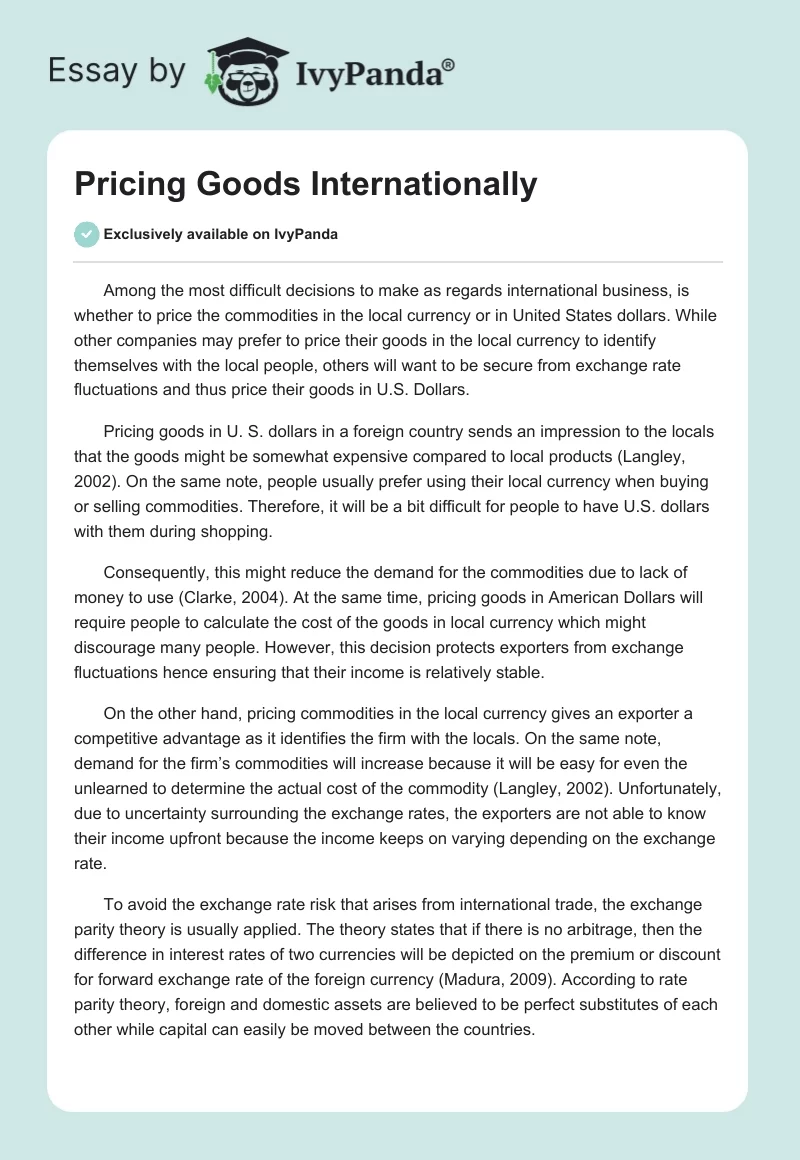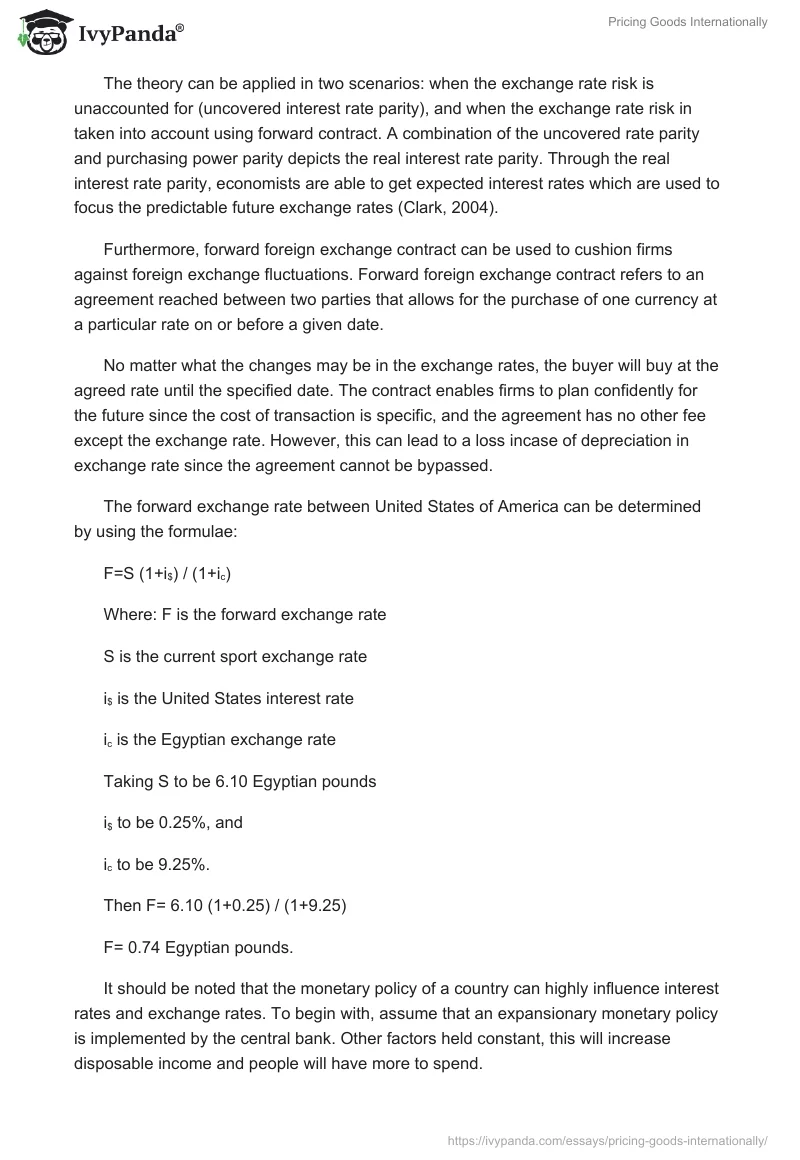Among the most difficult decisions to make as regards international business, is whether to price the commodities in the local currency or in United States dollars. While other companies may prefer to price their goods in the local currency to identify themselves with the local people, others will want to be secure from exchange rate fluctuations and thus price their goods in U.S. Dollars.
Pricing goods in U. S. dollars in a foreign country sends an impression to the locals that the goods might be somewhat expensive compared to local products (Langley, 2002). On the same note, people usually prefer using their local currency when buying or selling commodities. Therefore, it will be a bit difficult for people to have U.S. dollars with them during shopping.
Consequently, this might reduce the demand for the commodities due to lack of money to use (Clarke, 2004). At the same time, pricing goods in American Dollars will require people to calculate the cost of the goods in local currency which might discourage many people. However, this decision protects exporters from exchange fluctuations hence ensuring that their income is relatively stable.
On the other hand, pricing commodities in the local currency gives an exporter a competitive advantage as it identifies the firm with the locals. On the same note, demand for the firm’s commodities will increase because it will be easy for even the unlearned to determine the actual cost of the commodity (Langley, 2002). Unfortunately, due to uncertainty surrounding the exchange rates, the exporters are not able to know their income upfront because the income keeps on varying depending on the exchange rate.
To avoid the exchange rate risk that arises from international trade, the exchange parity theory is usually applied. The theory states that if there is no arbitrage, then the difference in interest rates of two currencies will be depicted on the premium or discount for forward exchange rate of the foreign currency (Madura, 2009). According to rate parity theory, foreign and domestic assets are believed to be perfect substitutes of each other while capital can easily be moved between the countries.
The theory can be applied in two scenarios: when the exchange rate risk is unaccounted for (uncovered interest rate parity), and when the exchange rate risk in taken into account using forward contract. A combination of the uncovered rate parity and purchasing power parity depicts the real interest rate parity. Through the real interest rate parity, economists are able to get expected interest rates which are used to focus the predictable future exchange rates (Clark, 2004).
Furthermore, forward foreign exchange contract can be used to cushion firms against foreign exchange fluctuations. Forward foreign exchange contract refers to an agreement reached between two parties that allows for the purchase of one currency at a particular rate on or before a given date.
No matter what the changes may be in the exchange rates, the buyer will buy at the agreed rate until the specified date. The contract enables firms to plan confidently for the future since the cost of transaction is specific, and the agreement has no other fee except the exchange rate. However, this can lead to a loss incase of depreciation in exchange rate since the agreement cannot be bypassed.
The forward exchange rate between United States of America can be determined by using the formulae:
F=S (1+i$) / (1+ic)
Where: F is the forward exchange rate
S is the current sport exchange rate
i$ is the United States interest rate
ic is the Egyptian exchange rate
Taking S to be 6.10 Egyptian pounds
i$ to be 0.25%, and
ic to be 9.25%.
Then F= 6.10 (1+0.25) / (1+9.25)
F= 0.74 Egyptian pounds.
It should be noted that the monetary policy of a country can highly influence interest rates and exchange rates. To begin with, assume that an expansionary monetary policy is implemented by the central bank. Other factors held constant, this will increase disposable income and people will have more to spend.
As a result, more people will be willing to deposit their money in banks. At the same time, banks will be having excess liquidity which they would be more than willing to offload by way of loans to people. Unfortunately, people will be unwilling to take loans because of excess liquidity. Under this scenario, money supply will exceed money demand and interest rates will be high.
Consequently banks will be forced to reduce interest rates to stimulate demand for loans. It is important to note here that as interest rates reduce, demand for loans from banks will be triggered and continue rising until a state of equilibrium between interest rates and demand for money is reached (Langley, 2002). Therefore, monetary policy either decreases or increases interest rates depending on whether it is expansionary or contractionary.
On the same note, there is a very strong relationship between interest rates and exchange rates. Increase in interest rates leads to increase in the rate of return on foreign currency assets. All other factors held constant, the increase in rate of return causes depreciation in the exchange rate (Madura, 2009). The opposite is true when expansionary monetary policy is implemented instead of the contractionary monetary policy.
However, apart from the monetary policy and interest rates there are other factors that influence exchange rate fluctuations. First and foremost, there is inflation rate which determines the prices of commodities. When inflation rate is higher the commodities of a country become relatively expensive and exports decline.
Consequently, fewer people will need the currency of that country which will lead to depreciation of the exchange rate. Secondly, current account deficit implies that the country’s demand for foreign currency is more than it supplies. In other instances, to reduce the deficit some governments depreciate their currency. Similarly, large public debt requires servicing either through borrowing or through other means. In some cases this will lead to increased inflation and hence depreciation in exchange rates (Langley, 2002).
On the other hand, if speculators think that the value of a currency will increase in future, demand for the currency will increase hence the exchange rate will rise. Moreover, political instability highly influences the confidence of investors and their willingness to invest; and by extension the exchange rate. In some instances, governments can also interfere directly with the exchange rate when they want to fix the exchange rate at a specific rate.
Though all of these factors might not be applicable in Egypt, some will definitely be applicable. Political stability in Egypt is not guaranteed if what was experienced recently is anything to go by. Though the regime people were fighting against was toppled, the economy has not fully recovered from the effects of the riots.
On the same note, Egypt operates on a current account deficit year in year out and this is something to take note of. Moreover, inflation is not very predictable when it comes to Egypt and this can influence the exchange rate. Nevertheless, Egypt pegs its exchange rate on the U.S. dollar and this can reduce the exchange rate fluctuations.
References
Clark, P. B. (2004). A New Look at Exchange Volatility and Trade Flows. Washington: International Monetary Fund.
Langley, V. S. (2002). Exchange Rate Volatility and International Agricultural Trade. Ontario: Captus Press.
Madura, J. (2009). International Financial Management. Stanford: Cengage Learning.


